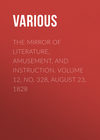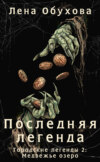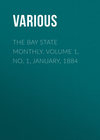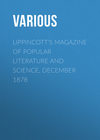Czytaj książkę: «The Mirror of Literature, Amusement, and Instruction. Volume 12, No. 328, August 23, 1828»
ANCIENT PLAN OF OXFORD CASTLE
By these mysterious ties the busy pow'r
Of mem'ry her ideal train preserves
Intire; or, when they would elude her watch,
Reclaims their fleeting footsteps from the waste
Of dark oblivion.
AKENSIDE
Gentle, courteous, and patient reader—to understand the above plan, it is requisite that you carry your mind's eye back to those troublous times when men enjoyed no protection, but in opposing force to force; and to a period when every man's house was his castle, though not in the metaphorical sense we have since been accustomed to apply these words, viz. to the protection and security of British subjects.
Few portions of our island have been more amply illustrated, by antiquarians, than OXFORD; and from one of these we learn that a Keep Tower, or Castle, existed here a considerable time before the conquest; for Alfred lived here; and Harold Harefoot was crowned and resided here; and one of Alfred's sons struck money here. Hearne has likewise identified this fact by the very ancient and original arms of Oxford, which have a castle represented, with a large ditch and bridge. Upon the same authority we learn that Offa "built walls at Oxford," and by him, therefore, a Saxon castle was originally built at Oxford.
Leland, Dugdale, and Camden, on the other hand, affirm that the castle at Oxford was built by Robert D'Oiley, who came into England with William the Conqueror; and the Chronicles of Osney Abbey, preserved in the Cottonian library, even ascertain the precise date of this great baron's undertaking, viz. A.D. 1071. No question, therefore, can remain, but that this illustrious chieftain either repaired or rebuilt the castle; but as we have shown, upon equal authority, there was a Saxon castle, fit for a royal residence at Oxford, long previous to D'Oiley's time. About the year 1794, several Saxon remains were discovered here; but our engraving represents the castle in Norman times, with Robert D'Oiley's magnificent additions, and is a facsimile of a plan by Ralph Agas, in 1538, which, allowing a little for bad or unskilful drawing, may be taken as a perfect specimen of Norman military architecture, and will, we are persuaded, be received by our readers as a popular and interesting illustration of the warlike character of the age in which the castle was erected.
For the description we are indebted to a MS. account of Anthony Wood, in the Bodleian library, who informs us that at one of its entrances was "a large bridge, which led into a long and broad entry, and so to the chief gate of the castle, the entry itself being fortified, on each side, with a large embattled wall; and having several passages above, from one side to the other, with open spaces between them, through which, in times of storm, whenever any enemy had broken through the first gates of the bridge, and was gotten into the entry, scalding water or stones might be cast down to annoy them."
On passing through the gate, at the end of this long entry, the fortification stretched itself, on the left hand, in a straight line, till it came to a round tower, that was rebuilt in the 19th of Henry III.1 And from thence went a fair embattled wall, guarded for the most part with the mill-stream underneath, till it came to the high tower joining to St. George's church.2
From hence, says the manuscript, the wall went to another gate, now quite down, opposite to the abovementioned; and leading to Osney, over another bridge; close to which joined that lofty and eminent mount, sometime crowned with an embattled tower. The manuscript adds, that for the greater defence of this castle, there was, on one of the sides of it, a barbican; which seems to have not merely been a single tower, but (according to an ancient deed) a place, or outwork, containing several habitations; and from other accounts it further appears, that there were more barbicans than one.
The ruins of certain other towers of the castle, besides the barbicans, and those already described, are also said to have been standing till 1649; when they were pulled down to erect new bulwarks for the parliamentary garrison.
This is an abstract of Anthony Wood's manuscript, which agrees with Agas's drawing, except that in his sketch, the tower between the gate-tower and St. George's, is represented square instead of being round. Antiquarians also infer that in the drawing it was intended to represent the great keep-tower as standing upon the top of the mount, and not by the side of it.3
Some discoveries made in 1794, throw much light on the history of the castle, and warrant a conclusion that in its area were several buildings. Wells were then cleared out, and among the rubbish were found horses' bones, dogs' bones, horse-shoes, and human skeletons; the appearance of the latter is not easily accounted for, unless they were the bodies of malefactors, who had been executed on the gallows placed near the castle, in later ages, that might have been flung in here, instead of being buried under the gibbet. We must however pass over many interesting facts, and content ourselves with a mere reference to the empress Maud being besieged here in 1141, and her miraculous flight with three knights, all escaping the eyes of the besiegers by the brightness of their raiment; Maud having just previously escaped from the castle of the Devizes, as a dead corpse, in a funeral hearse or bier. The reader will not be surprised at the decay of the castle, when he is informed that it was in a dilapidated state in the reign of Edward III.
The castle was situate on the west side of the city of Oxford, on the site of the present county gaol. In 1788 little remained except the tower, which was for some time used as the county prison, and part of the old wall could then be traced 10 feet in thickness. In the castle-yard were the remains of the ancient sessions-house, in which, at the Black Assize, in 1577, the lieutenant of the county, two knights, eighty esquires and justices, and almost all the grand jury, died of a distemper, brought thither and communicated by the prisoners; and nearly one hundred scholars and townsmen fell victims to the same disorder.
We have been somewhat minute in the preceding description, but we hope not more so than the exhaustless curiosity of the public on such subjects appears to warrant. Indeed, these interesting details are only a tithe portion of what we might have abridged. The warlike habits of our ancestors are always attractive topics for inquirers into the history of mankind, and their study is not
Dull and crabbed as some fools suppose,
but a treasury or depository of useful knowledge, by enabling the inquirer to draw many valuable inferences from the comparative states of men in the several ages he seeks to illustrate. The enthusiasm of such pursuits is, likewise, an everlasting source of delight; for who can visit such shrines as Netley, St. Albans, or Melrose, without feeling that he is on holy ground; and although we are equally active in our notice of the architectural triumphs of our own times, we must not entirely leave the proud labours of by-gone ages to be clasped in the ponderous folio, or to moulder and lie neglected on the upper shelves of our libraries.
We have to acknowledge the loan of the original of the engraving, from a lineal descendant of D'OILEY4, the founder or repairer of the Castle at Oxford—a name not altogether unknown to our readers.
THE "INTELLECTUAL CAT."
(For the Mirror.)
The cat mania has hitherto been more popular in France than in England. To be sure, we have the threadbare story of Whittington and his cat; Mrs. Griggs and her 86 living and 28 dead cats; Peter King and his two cats in rich liveries; Foote's concert of cats; and the newspaper story of tortoiseshell male cats—but in France, cats keep better company, or at least are associated with better names. Thus, MOLIERE had his favourite cat; Madame de Puis, the celebrated harpplayer, settled a pension on her feline friend, which caused a law-suit, and brought into action all the most celebrated lawyers of France; and M. L'Abbe de Fontenu was in the habit of experimenting on these animals, one of which he found could exist twenty-six months without drinking! which fact is recorded in the History of the Royal Academy of Sciences at Paris, 1753.
Our present portrait is, however, of more recent date, being a free translation from Le Furet de Londres, a French paper published in London, whose columns are an agreeable accompaniment for a cup of coffee. It is a mere bagatelle, and as an amusive trifle may not be unacceptable.
My pretty little Puss, it is high time that I should pay a just tribute to your merits. We often talk of people who do not esteem you; therefore, why should I blush to give publicity to your perfection?
You are exceedingly well made; your fur boasts of the delicate varieties of the tiger; your eyes are lively and pleasing; your velvet coat and tail are of enviable beauty; and your agility, gracefulness, and docility are, indeed, the admiration of all who behold you! Your moral qualities are not less estimable; and we will attempt to recapitulate them.
In the first place, you love me dearly, or at least you load me with caresses; unless, like the rest of the world, you love me for yourself's sake. I know well that you like me less than a slice of mutton, or the leg of a fowl, but that is very simple; I am your master, and a leg of mutton is as good again as one master, twice as good as two masters, &c.
You possess great sense, and good sense too, for you have precisely such as is most useful to you; for every other kind of knowledge will make you appear foolish.
Nature has given you nails, which men unpolitely call claws; they are admirably constructed, and well jointed in a membrane, which is extended or drawn up like the fingers of a glove; and at pleasure it becomes a terrific claw, or a paw of velvet.
You understand the physical laws of good and evil. A cat who strangles another will not be more culpable than a man who kills his fellow men. My dear Cat, the great Hobbes never reasoned more clearly than you do!
You forget the past—you dream not of the future; but you turn the present to account. Time flies not with you, but stands still, and all your moments appear but as one. You know that your muscles will give action to your limbs, and you know no other cause of your existence, than existence itself. My dear Cat, you are a profound materialist!
You flatter the master who caresses you, you lick the hand that feeds you, you fly from a larger animal than yourself, whilst you unsparingly prey on the smaller ones. My dear Cat, you are a profound politician!
You live peaceably with the dog, who is your messmate; in gratitude to me, you regulate your reception, good or bad, of all the animals under my roof; thus, you raise your claw against such as you imagine mine enemies, while you prick up your tail at the sight of my friends. My dear Cat, you are a profound moralist!
When you promenade your graceful limbs upon a roof, on the edge of a casement, or in some situation equally perilous, you show your dexterity in opposing the bulk of your body to the danger. Your muscles extend or relax themselves with judgment, and you enjoy security where other animals would be petrified with fear. My dear Cat, you perfectly understand the laws of gravity!
If through inadvertence, blundering, or haste, you lose your support or hold, then you are admirable; you bend yourself in raising your back, and carry the centre of gravity towards the umbilical region, by which means you fall on your feet. My dear Cat, you are an excellent natural philosopher!
If you travel in darkness, you expand the pupil of your eye, which, in forming a perfect circle, describes a larger surface, and collects the greater part of the luminous rays which are scattered in the atmosphere. When you appear in daylight, your pupil takes an elliptic form, diminishes, and receives only a portion of these rays, an excess of which would injure your retina. My dear Cat, you are a perfect optician!
When you wish to descend a precipice, you calculate the distance of the solid points with astonishing accuracy. In the first place, you dangle your legs as if to measure the space, which you divide in your judgment, by the motions of your feet; then you throw yourself exactly upon the wished-for spot, the distance to which you have compared with the effect on your muscles. My dear Cat, you are a skilful geometrician!
When you wander in the country, you examine plants with judicious nicety; you soon select that kind which pleases you, when you roll yourself on it, and testify your joy by a thousand other gambols; you know also the several grasses, and their medicinal effects on your frame. My dear Cat, you are an excellent botanist!
Your voice merits no less eulogium; for few animals have one so modulated. The rhyming pur of satisfaction, the fawning accents of appeal, the vigorous bursts of passion, and innumerable diatonic varieties, proceed from your larynx, according to the order of nature. My dear Cat, you are a dramatic musician!
In your amusements, you prefer pantomime to dialogue; and you neglect the pen to study the picture. But then what agility! what dancing! what cross-capers! The difficulty never impairs the grace of the feat. Oh, my dear Cat! you are a delightful dancer!




















